![]()
![]()
![]()
Use LEFT and RIGHT arrow keys to navigate between flashcards;
Use UP and DOWN arrow keys to flip the card;
H to show hint;
A reads text to speech;
72 Cards in this Set
- Front
- Back
|
Definition on a hydrolysis reaction |
A hydrolysis reaction involves the the breakdown of a chemical bond between 2 molecules and the use of a water molecule |
|
|
Which polysaccharides are energy stored |
Glycogen and starch |
|
|
Which polysaccharide contains beta glucose |
Cellulose |
|
|
Definition on polymer |
Polymers are large molecules made up of repeating monomers |
|
|
What is a saturated fatty acid |
Have all single bonds between Carbon atoms |
|
|
What type of bond forms between polysaccharides |
Glycosidic bonds |
|
|
Describe the structure of starch and its reasons for such adaptations |
Helical shape - compact store of glucose Has a branched structure - more points for hydrolysis to occur which releases glucose which is used in respiration to provide energy Large molecule - contains lots of glucose Insoluble - remains where it was formed so it is osmotically inactive so it is unable to cross the cell membrane |
|
|
How manny ester bonds are in a triglyceride and what is the function of an ester bond |
3 Joins fatty acids to glycerol |
|
|
Definition of a condensation reaction |
A reaction which joins 2 molecules together with the formation of a chemical bond and involves the elimination of a water molecule |
|
|
Are triglycerides polymers and why |
No, they are made up of fatty acids and a glycerol. Not a repeating monomer |
|
|
Glucose + Glucose -----> |
Maltose + Water |
|
|
Glucose + Fructose -----> |
Sucrose + Water |
|
|
Describe the structure of cellulose |
Long straight chains of beta glucose which are cross linked by hydrogen bonds to form microfibrils. Bands of microfibrils form macrofibrils which provide strength and stability Small holes in the structure so its fully permeable Every other beta glucose is inverted which forms the straight structure No branching Found in cell wall to provide strength to prevent osmolysis (cell from bursting) |
|
|
What is an unsaturated fatty acid |
Contains at least 1 double bond between carbon atoms |
|
|
Describe the emulsion test |
Add small amounts of ethanol to the sample, shake so the fat dissolves. Add water and mix the contents. A positive test will provide a white emulsion |
|
|
Name 3 disaccharides |
Maltose Sucrose Lactose |
|
|
Properties of the tail in a phospholipid |
Non-polar Repel water Hydrophobic |
|
|
Which polysaccharide is a structural component of a cell |
Cellulose |
|
|
Name 3 monosaccharides |
Glucose Fructose Galactose |
|
|
What is the structural difference between alpha glucose and beta glucose |
Alpha glucose have both OH groups connected to the bottom carbons |
|
|
Which disaccharides are reducing sugars |
Maltose Lactose |
|
|
Which color would a polysaccharide provide when tested with a Benedict's |
Blue Non-reducing |
|
|
Describe the structure of glycogen |
Large molecule - contains a large number of glucose molecules which can be used in respiration to provide energy Very branched structure - more points of hydrolysis so glucose can be released at a faster rate Insoluble - stays in the cell as its osmotically inactive |
|
|
Which polysaccharides contain alpha glucose |
Starch Glycogen |
|
|
What is the function of fats |
Store of energy Insulation Protects organs Found in cell membranes |
|
|
Glucose + Galactose ------> |
Lactose + Water |
|
|
What 3 ways can you hydrolyze a lipid |
Heat with acid Heat with alkali Use the enzyme lipase at optimum temperature and p.H |
|
|
What is the function of monosaccharides |
To be used in respiration and provide energy |
|
|
What are the properties of lipids |
Store 2x hydrogen than carbohydrates Insoluble in water Soluble in alcohol |
|
|
Monosaccharides will provide what color as a result to a Benedict's test |
Brick red |
|
|
Name 3 polysaccharides |
Glycogen Starch Cellulose |
|
|
Complete the equation Glycerol + 3 fatty acids------> |
Triglyceride + 3 waters |
|
|
Describe the properties of the phospholipid head |
Polar (has a charge) Attracts water Hydrophilic |
|
|
Definition of a monomer |
Basic unit i.e amino acid, glucose or a nucleotide |
|
|
Which elements are found In protein |
Carbon Hydrogen Oxygen Nitrogen Sulfur (sometimes) |
|
|
Is a protein a polymer |
Yes because they consist of a single monomer - amino acid |
|
|
What are the 2 groups in the structure of an amino acid |
Amine group Carboxylic group |
|
|
If the atomic group R is polar in an amino acid will it be soluble or insoluble |
Soluble |
|
|
What type of bond forms between 2 amino acids |
Peptide bonds |
|
|
Describe the primary structure |
The specific sequence of amino acids in a polypeptide chain which determines the function of a protein |
|
|
Describe the secondary structure |
This is the folding of a polypeptide chain. Hydrogen bonds are formed to hold the shape together. Examples are alpha helix and beta pleated sheets |
|
|
Describe the tertiary structure |
This is the specific folding of the secondary structure. This contains peptide, hydrogen, ionic and sometimes disulfide bonds |
|
|
What type of a bond is a disulfide bond |
Covalent bond which means they are very strong so less likely to break at high temperatures |
|
|
Describe the quaternary structure |
Contains more than 1 tertiary structure. Haemoglobin contains 4 |
|
|
What level of structure do enzymes have |
They have specific tertiary structures |
|
|
What do enzymes do |
They lower the activation energy They are biological catalysts which speed up reactions |
|
|
Are enzymes globular ( soluble in water ) |
Yes |
|
|
Describe the induced fit model |
Active site is not initially complementary to the substrate Active site has a degree of flexibility Substrate interacts with the enzyme causing it to change shape As the enzyme changes shape, a strain in placed on the bonds within the substrate which lowers the actuation energy |
|
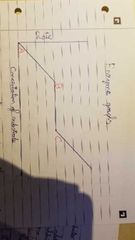
Describe what is happening at A,B,C |
A - as concentration of substrate increases there are more successful collisions. Therefore more enzyme substrate complexes are formed B - all active sites are occupied so the enzymes are working at maximum rate C - addition of enzymes |
|
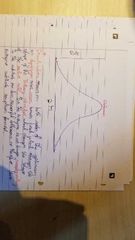
Understand this graph |
Understand the graph |
|
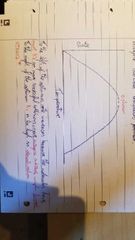
Understand the graph |
Denaturation is explained in a differnt question |
|
|
Describe a competative inhibitor |
Similar shape to the substrate Prevents normal substate from binding so less enzyme substrate complexes are formed They bind to the active site They can be overcome by the addition of more substrate |
|
|
Describe non competitive inhibitors |
Differnt shape to the substrate Binds to the allosteric site Causes the active site to change shape so no enzyme substrate complexes can be formed Can't be overcome |
|
|
Is DNA a polymer |
Yes because it contains a a single monomer which is a nucleotide |
|
|
Does the base contain nitrogen |
Yes |
|
|
What are the complementary base pairs |
C-G A-T |
|
|
Which type of bond joins nucleotides |
Phophodiester bonds |
|
|
What are the 3 components of a nucleotide in DNA |
Deoxyribose sugar Phosphate Base |
|
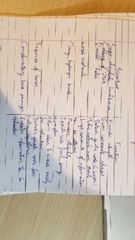
Structure and functions of dna |
Structure and functions of dna |
|
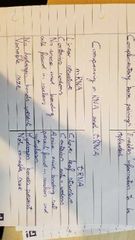
Comparing RNA and tRNA |
Comparison |
|
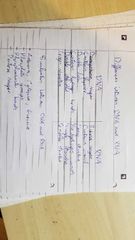
Similarities and differences between DNA and RNA |
Comparison |
|
|
Describe DNA replication |
DNA helicase breaks hydrogen bonds which causes the DNA to uncoil Both stands act as templates Free nucleotides align up accordingly to complementary base pairs DNA polymerase joins adjacent nucleotides by condensation reactions which form phophodiester bonds Hydrogen bonds reform between complementary base pairs |
|
|
Function of sodium ion |
Co-transports glucose and amino acids across cell membranes |
|
|
Function of iron ion |
Component of haemoglobin which transports oxygen |
|
|
Function of hydrogen ion |
Important in determining the p.H and therefore the protein structure and enzyme activity |
|
|
Function of phosphate ions |
Important for structural components of DNA, RNA and ATP |
|
|
Describe how water is a metabolite |
Water is a metabolite Water is a solvent for reactions to occur Needed in photosynthesis/produced in respiration. |
|
|
Describe how water is a solvent |
Water is the solvent in which metabolic reactions occur Many substances are soluble in water. This is why substances can be transported around plants and animals Also used to remove excretory products such as urine which consists of urea, water and salt |
|
|
Describe how water has a high specific heat capacity |
The heat capacity is the amount of heat required to raise the temperature of an object or substance by 1°C It has a high specific heat capacity because there are many hydrogen bonds between water molecules need to be broken to increase the temperature -Absorbs a lot of heat energy before increase in temperature -Minimise temperatures increase in cells due to biochemical reactions -Helps prevent dangerous fluctuations in aquatic habitats |
|
|
Describe how water has a high latent heat of vaporsation |
This is the enthalpy change required to transform a substance from a liquid to a gas It is high because water has hydrogen bonds holding it together This has a cooling effect |
|
|
Describe how water has cohesion |
Cohesion is the tendancy of water molecules to stick together Due to hydrogen bonds, water has large cohesive forces This allows water to move through a tube Where water meets the air they tend to be pulled back rather than escape Surface tension causes the water to act as a skin which is strong enough to support small organisms |
|
|
Describe how water provides support |
Water is not easily compressed so this provides support in non-woody plants via turgor pressure and in some animals e.g. hydrostatic skeletons. Provides buoyancy for aquatic organisms |

